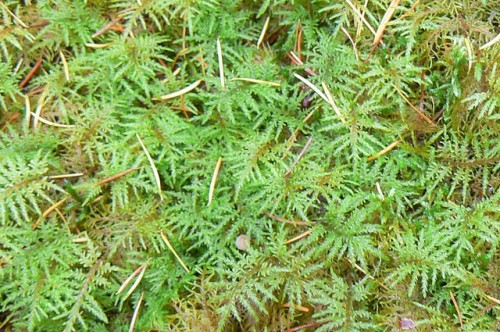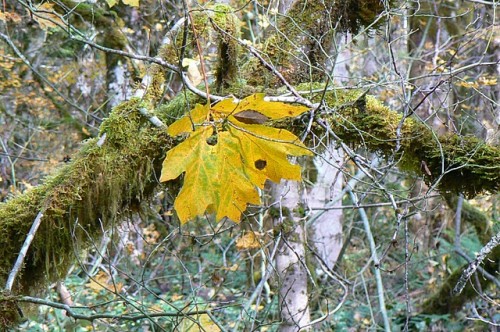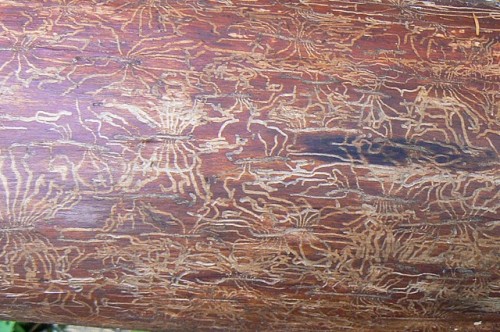Watching the waterfall, bearing witness
An alder leaf on a trail. A chance encounter between a weasel and a hawk. The mad rush of a waterfall.
These images – and more – were captured in words by the participants in the North Cascades workshop Sit, Walk, Write: Nature and the Practice of Presence, held at the Environmental Learning Center on October 23 – 25, 2009. For the past two seasons, Kurt Hoelting and I, Holly Hughes, have had the pleasure of leading this workshop the last weekend in October. At this workshop, we literally sit, walk and write as a way to more deeply engage with the natural world. Kurt- a writer and teacher of meditation – and I -poet, essayist and teacher of writing – both believe strongly in the value of combining meditation with writing as a way to deepen and reflect on our experience of the natural world.
Our time together goes like this – We begin the day with sitting meditation, followed by a brief period of walking meditation or Qi Gong, eat breakfast together in silence, then gather to read poems and prose that illustrate the practice of paying attention that meditation encourages. In the afternoon, we hike with an North Cascades Institute naturalist, learning more about the woods around us, and spend the rest of the day writing and reflecting on what we are observing. In the evening, we gather to share our writings then end the day by sitting together in meditation. Throughout, we are practicing attention – attention to our breath as we meditate, attention to the shimmering gold of the aspen leaves as we hike up a trail. Our hope is that by paying attention, we will become more present to ourselves and our world, and in doing so, we might feel called to bear witness.
Participants of the 2009 Sit, Walk, Write Retreat embarking on a naturalist hike
Bearing witness is a theme that emerges in the writings gathered here – bearing witness to our inner lives, beginning by paying attention to our breath, to bearing witness to what we see happening in the world around us. On this blog you’ll read how a lake becomes a lover, how the smell of decaying leaves evokes thoughts of mortality and how a chance encounter between a weasel and a hawk asks us to learn what the forest has to teach. You’ll see evidence of how the practice of meditation and writing, together, can remind us what we know – that “in this wild place, everything needed is here. Everything here is needed.â€
Our gratitude to the staff of the North Cascades Institute for their wonderful programs and for sponsoring this workshop and, of course, to the participants for sharing their writing. I hope you’ll enjoy this collection and might join us another fall to sit, walk and write.
~Introduction by Holly J. Hughes
Writings from the 2009 Sit, Walk, Write Retreat
Breath By Shelley Spaulding
The back feels tight, hard, burning.
Breathe, breathe, breathe.
Feel the breath, not the back.
Mindful of the storm,
Mindful of the calm.
Mindful of the breath.
Punctuate the posture
With the breath
With the storm.
Let the breath go.
Watch the breath return.
All is calm.
All is alive.
Feet are tingling!
Susan Fish-Sadin sitting in thought beside Sourdough Creek
Lady Diablo By Laura Lowery
I do not yet know this lake spirit well.
I have only met her twice – yesterday and today.
But today she is argumentative.
The wind is her husband and they are having a row.
He really ruffles his lady’s feathers.
On the surface she is disturbed by his huffing and puffing.
But that is just for show,
so he can feel like his howling makes a difference to her.
Beneath, she is the same as she has always been – deep, steady, smooth.
Or perhaps the wind is a lover,
only here for a short while.
Usually unannounced, always welcomed by her.
They dance and embrace.
This lover moves her and she sparkles for him.
Her waves beckon and retreat in play.
The wind gusts, then goes soft.
When he leaves, her watery edges lap the earth
like a small kitten drinking cream.
Contented.
The ripples of Diablo Lake in the afternoon light
A Sponge By Rich Hawkins
I am a sponge.
When I walk, I walk on spongy feet.
My flesh—an assembly of pliable chambers,
holders of water,
and whatever water holds,
alert to any touch,
yielding to any pressure,
soaking up whatever comes,
whatever flows.
I am the flow.
I am water.
It is my nature only to fall,
to seek the low places that others disdain,
sliding past the obstacles,
pouring into any opening in my path,
and when it’s full of me, or I of it,
flowing on without regret.
I fall into each moment.
I fall into the now.
I am the water.
I am the sponge.
I am . . .
Excuse me?
Yes?
I’m interrupting.
Why, no. Not at all.
But, you seem so . . . self-absorbed.
 The spongy nature of mosses in the forests around the Learning Center
The spongy nature of mosses in the forests around the Learning Center
When Else Does Death Smell So Sweet? By Kurt Hoelting
When else does death smell so sweet,
Or invade the world with such shameless glory?
Pressed into life from the ground it has already made,
Even as the wind calls it back down from the sky.
The vine maple already knows all this,
Cracked from the earth by a single seed.
Who can say where this circle began?
If not now, in the cold furnace of October?
After the first freeze has announced the
Color yellow to the farthest reaches of the valley.
Showering the forest with rivers of brightness
It has captured from the warm flesh of sunlight.
If only I could let go with such grace
Bursting apart in flames of shattered sunlight
That sink again into the living soil,
What use would I have for fear?
 Remnants of a Bigleaf Maple leaf amidst the vine maple branches
Remnants of a Bigleaf Maple leaf amidst the vine maple branches
Sitting in the Forest with Questions By Karen Prince
Notice the damp. The sweet smell. The crocheted curtains of yellow hanging from dozens of maples. Walk on the mosaic carpet of reds and yellows, caramel and brown, burgundy and bronze created by multitudes of leaves already fallen. Listen to the gurgling stream, the occasional bird chirp. But mostly, inhale the quiet. Move mindfully. Step over the wet ferns and sit beside the stream on this fallen log. Watch two more yellow leaves spiral down – a graceful departure from life on the branch.
What kind of tree is that? A jagged, partly-burned tree snag leans away from the stream.  Was it hit by lightning? It is stripped on one side, has a reddish cedar – colored stripe in its middle. Is it a cedar?  Suddenly, a hawk-like bird swoops onto it, wings outstretched. I sit as still as the log. Is that a hawk? What kind? A white band like a laurel crown surrounds his dark head. He has a light grey yoke and white-tipped tail feathers.  Piercing eyes survey the scene as he settles. Again, his wings open revealing a soft checkerboard of grey and white as he flaps to a neighboring tree.
Now what? A weasel-like animal emerges from the messy forest floor – fallen logs, rocks and jumbled flora. He scampers part way up the tree trunk then turns and quickly moves to an adjacent stump eyeing the hawk above as he shifts from foot to foot, fluffing his impressive wings. What conversation are they having? Is the hawk thinking of weasel dinner? Is the weasel going to attack the hawk? Is the weasel trying to divert the hawk’s attention from a nest? Is it a weasel? It has a mean little triangle face attached to a sinuous body. Carnivore? Would it come after me? Could it be a ferret? No, people make pets of those. A marten? A marlin? No, that’s a fish.
I am confronted with my ignorance of life in these woods. I want to name and know what I see around me – the animals, the plants – to feel connected. Likewise, I want to name and know better my own interior landscape – to feel centered. Here I embrace quietude and the chance to sit with it – to listen, to learn. In my quest to live my life truthfully, fully, I ask what lessons the forest can teach: celebrate complexity – the tangles of underbrush, the communities of unknown inhabitants; recognize much lives under the surface – mushroom producing mycorrhizal webs (fact just learned); welcome diversity – hemlocks, Douglas firs, alders, giant alders, cedars and maples; understand – in this wild place everything needed is here. Everything here is needed.
Vida Morkunas observing the fall landscape in the North Cascades
I cannot capture this waterfall in words By Ron Hobbs
This mad rushing of water, this stuff of life distilled from seawater and clouds, throwing itself over a cliff and falling into the deep gravitational embrace of the Earth on its journey to find the lowest place. I cannot write Now!
But perhaps I can write now and then. My thoughts rush like that waterfall, but look at the cliff, that bold pinnacle of rock that appears to thrust itself up into the Sky. It seems so solid, so enduring. But the cliffs, the pinnacles, the mountains themselves, are different from the waterfall only in the time frame of their cycling. This rock arrived here buried deep within the Earth as it was thrust up by chthonic forces from within its core. To paraphrase Michelangelo, this apparently solid cliff is merely what is left after what is not essential has been carved away, falling with the water back toward the heart of the Earth, which is its home. Some distant day this edifice will return to the sea as well.
While I sit here pondering this great drama of water, time and stone, the waterfall is gone, flowing on back to the undifferentiated sea, another rush of water taking its place in the here and now. I want to capture every last drop of meaning, but that is impossible. Let me then write the story of, let me bear witness to, this stone and this drop of water that is before me now.
Basking in the sunlight near the Waterfall Overlook
On the Way to Bearing Witness By Holly Hughes
Walking down the path to the lake, I come upon a birch, bark stripped to its heartwood, revealing a dark, rectangular wound. Even here in this pristine wilderness, I find myself thinking. But is wilderness ever pristine? Or did we invent that word, needing to imagine it that way for our wounded spirits? Isn’t it always dying a little, always changing, always evolving? What is life but inexorable change?
I take a few steps more, then see a mushroom -–russula?—breaking through the dark earth, fed by all this rain and the community of mycorrhizae beneath the dark duff, somehow knowing its never too late to break free, to open its gills, to sing in the quiet, late sun.
 Noticing the small detailings on an exposed trunk is practicing presence
Noticing the small detailings on an exposed trunk is practicing presence
Bearing Witness By Deb Davis
(from the Central Cascades of Washington)
My graduate school art history professor maintained that we Americans don’t write manifestos, we deliver sermons. That was a disappointment to me, because I was so impressed as a teenager when I read Andre Breton’s Surrealist Manifesto. Sermons thundered from pulpits alarmed me, and never seemed to have anything to do with art or going outside.
Robert Michael Pyle takes the title of his book Walking the High Ridge from a quote by Vladimir Nabokov: “Does there not exist a high ridge where the mountainside of ‘scientific’ knowledge joins the opposite slope of ‘artistic’ imagination?†Pyle goes on to say that for as long as he’s written, “I’ve felt that naturalists who take their pleasure and heart from the land have an inescapable duty to speak up for it—and to convince and encourage others to do the same.â€
That high ridge has been home to me, both literally and figuratively, for most of my life. An interest in natural history led me to the edges of hard science, but I could never plunge into the numbers and analysis. Similarly, my artistic imagination interprets the natural world freely, but I’ve never been able to spend much time in pure abstract art. From my high ridge, I feel that inescapable duty to speak up. I can neither write a manifesto nor deliver a sermon. All I can do is bear witness.
I notice and speak for the small, the ordinary, the common and humble; as well as the damaged, crowded, packed-down, and broken. And for the magnificent, spectacular, once-in-a-lifetime. For the cataclysmic change of a forest fire in a familiar place. For an avalanche that alters a slope in seconds. For the glacier lilies that push yellow recurved petals out of the mud as soon as the snow melts every spring. Or for the subtle intrusion of real estate signs, then the road punched in, the dump trucks, the gates. For the Jaguars and BMWs that now show up at the hardware store and post office in my little town.
I will continue to go to the land of clearcuts, mowed down in the 1970s and 80s, now growing back in a profusion of firs marching in straight lines. I can tell the world how quiet it is there now that talkie-tooters no longer echo across canyons and you never see a logs truck. That the huckleberry crop can be stupendous and the songs of thrushes filter down from the canopy in the remnant patches of old-growth mountain hemlocks. These places are forgotten temples. Once I saw marbled murrelets flying there.
I will still go to the Alpine Lakes Wilderness to work on trails, even though it’s my opinion that its wilderness character has been compromised almost beyond redemption. On hot summer days, a brown smudge from the city hangs over the Cascade crest, and at night the urban glow reflects deep into the mountains. I can lie in my tent at Waptus Lake (I walked nine miles to get there) and tell time by when the first flight climbs out of Sea-Tac in the morning. I can look back in my journals to tell the story of when I first noticed glacial silt in Pete Lake, meaning that the Chimney Glacier is melting. The green color of the lake is sublime, but the bottom of the lake is gooey with glacier dust.
I can say all these things, always trying to express the childlike wonder I still feel at rain, wind, trees, flowers. I am nearly fifty years old and still a child. There have been so many changes, and things continue to change. I know that I cannot, will not flinch from the hard stuff of living in this world in this century.
Life is so fragile! Yet persistent yet fragile yet persistent.
—-
Stay up-to-date on North Cascades Institute’s Learning Center Programs and Field Excursions by clicking here.
Photos courtesy of Holly J. Hughes.


Very nice job! Thanks to North Cascades Institute personnel for offering this opportunity and providing the expertise to allow us to share our experience during an inspiring and renewing workshop in October 2009. Thanks to Holly Hughes for organizing the pieces. I am excited to see something I have written appear on line!